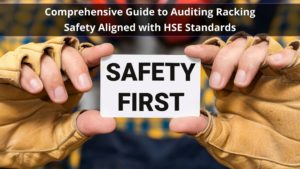
SEMA safety is a big umbrella with lots of different elements of storage equipment safety beneath it.
The Storage Equipment Manufacturers Association (SEMA) is something of an authority when it comes to storage equipment safety. Though their advice is superseded by HSE (Health and Safety Executive), SEMA safety is vital because it is much more specific. SEMA safety doesn’t contradict HSE safety. Rather, it expands on the advice given in HSE HSG76 and then goes into much more detail.
In this quick guide to SEMA safety, you’ll learn about the most basic and important aspects of SEMA safety and how to follow them.
1) The SEMA Code of Practice
More or less every conceivable instance of storage equipment safety is covered in the SEMA Code of Practice. This code is not one document, but many different documents which you can purchase from SEMA at various prices. Not all documents are relevant to all storage equipment users or warehouse owners. Their “Guide to the Specification of Freestanding High Bay Racking and Clad Racks”, for example, is not needed for those warehouse owners who don’t use freestanding high bay racking or clad racks.
If you find HSE HSG76’s advice lacking with regards to your specific storage equipment safety query, these guides are a good place to start. However, if you want to know more about specific elements of racking safety, there are other options.
2) Racking Inspection Training from a SEMA Approved Racking Inspector
The SEMA approved racking inspector program is by far the most rigorous safety program SEMA runs. This is closely followed by the SEMA Cantilever Racking Inspection course. As a result, there are only 104 SEMA approved pallet racking inspectors in the world (with inspectors based in Spain, the UAE, Singapore, and even China) and only 35 SEMA approved cantilever racking inspectors in the world.
A warehouse owner or storage equipment user does not need to take either course. The program is designed for people who want a career as a SEMA approved racking inspector, rather than someone who just wants to know how to operate their racking safely.
For the latter person, we would recommend our racking inspection training course performed by a SEMA approved inspector. Our SEMA approved racking inspector is one of the few people to have passed both the SEMA pallet racking inspection course and the SEMA cantilever racking inspection course. For that reason, our racking inspection training course is one of the best in the UK (with rave reviews from Tate Modern, Hayden’s Bakery, Dunlop, White Stuff, and many others).
If you want to learn about some of the elements of SEMA safety specific to your racking system, but are a little intimidated by the scale of the SEMA Code of Practice, we’d highly recommend our racking inspection training course.
3) SEMA Technical Bulletins
The SEMA Code of Practice is often updated — or elements of it are clarified — with technical bulletins. It’s important to keep an eye out for these as they are often reactions to things happening in the industry. The SEMA Technical Bulletin No. 3 clarifies SEMA and HSE’s interpretation of the use of rack protectors (among other things) in response to people’s incorrect use of them.
These bulletins are a key part of SEMA safety and are great because they are often backed up with direct quotes from HSE HSG76. In other words, these bulletins help storage equipment users to understand HSE HSG76 in context.
4) Racking Inspections by a SEMA Approved Inspector & Staff Racking Inspections
As previously mentioned, SEMA runs different courses in order to train SEMA approved racking inspectors (SARIs). Both HSE and SEMA recommend racking inspections from SARIs at least once a year. HSE also recommend regular inspections from “competent” staff. At Storage Equipment Experts, we believe the best way to ensure that your staff are “competent” enough to perform the regular staff-led inspection HSE recommend is through our racking inspection training course: a course delivered by a SEMA approved racking inspector (SARI).
The importance of “competence” is also echoed in the CDM regulations 2015. As a result, this makes training doubly important.
5) Other Elements of SEMA Safety
SEMA safety also includes many other aspects, such as correct practice for storage equipment installation, storage equipment repair, and the dismantling of storage equipment. Each element of racking safety is covered somewhere in its Code of Practice. Most of the emphasis of HSE warehouse safety and SEMA safety is on the use of racking (as this is what warehouse owners and storage equipment users will spend the bulk of their time doing) but it’s important to pay close attention to the other elements of SEMA safety too. If the worst happens, your racking might need repair or dismantling. When it does, you’ll be glad that what to do is covered by SEMA safety.
For a greater understanding of SEMA safety, contact Storage Equipment Experts today for racking inspection training from a SEMA approved racking inspector.




